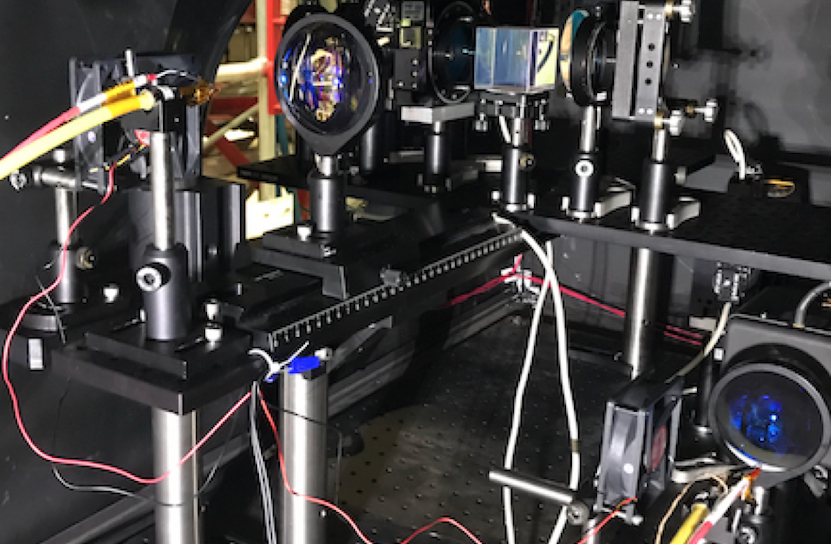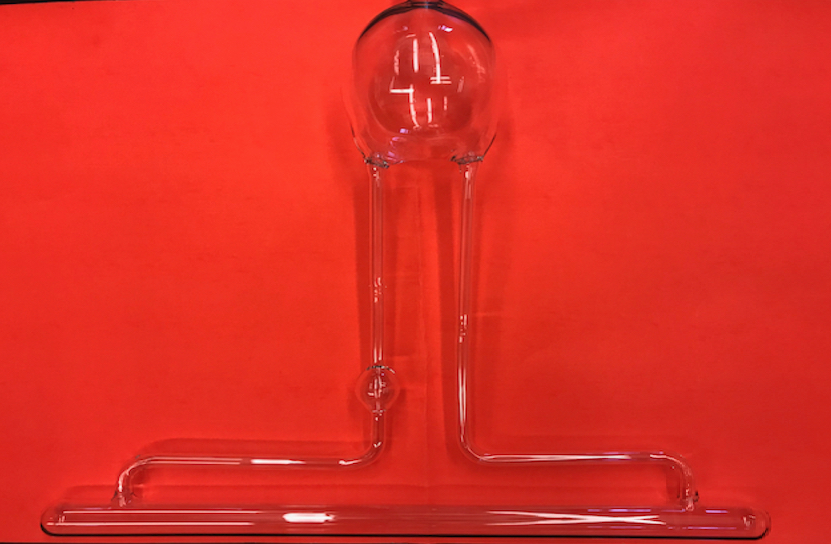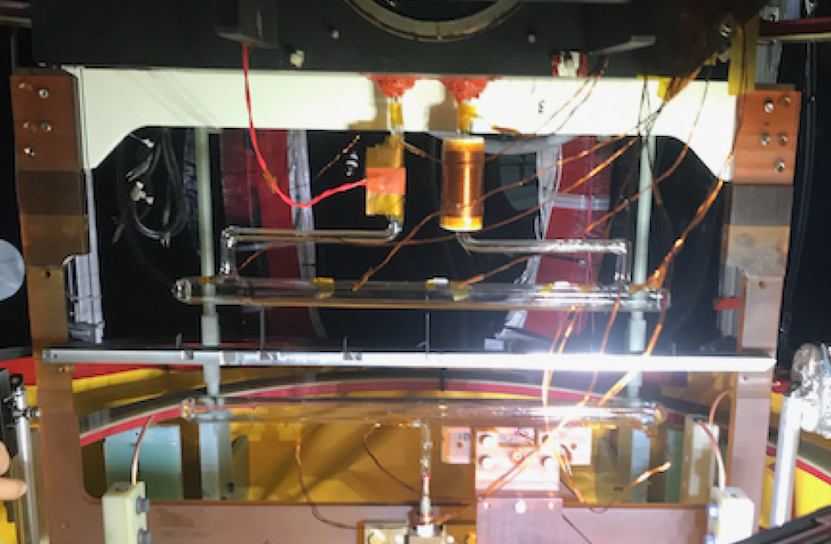A 22-year-old polarized helium target continues to improve through multiple alliances, record-breaking innovations, and progressively more powerful lasers
In 1998, a collaboration of researchers built a target to study the internal structure of the neutron, an important building block of the nucleus of the atom, for an upcoming experiment at the Department of Energy’s Thomas Jefferson National Accelerator Facility.
More than 20 years later, physicists are still using the polarized helium-3 target to understand how the neutron’s smaller constituent particles, named quarks, combine to give the neutron its overall properties. The target is an integral part of neutron studies conducted with Jefferson Lab’s Continuous Electron Beam Accelerator Facility, a DOE User Facility.
According to Jian-Ping Chen, a senior staff scientist at Jefferson Lab who has been the coordinator of the target since its inception, shooting electrons at it and examining how the electrons scatter off of the nuclei of helium atoms tells the researchers things they want to know about the neutron.
“This target has been a very, very powerful tool to study how the neutron works,” he said.
The target has been especially useful for learning more about neutron spin. Although it has always been used to study the neutron and spin structure of helium-3 nuclei, the target has not always remained the same.
The target is made of helium-3, a form of helium that contains one neutron in every one of its atoms. To study the spin of a neutron and its constituent quarks, the neutrons in the helium-3 must begin the experiment with their spin oriented in the same direction, a state known as polarized.
“The more neutrons whose spins are aligned, the better job we can do of studying the nuclear physics,” said Todd Averett, a professor of physics at the College of William & Mary who helps develop technology to improve the polarized helium-3 target.
That’s where the lasers come in.
To polarize the helium, researchers shine laser beams into the hand-blown glass cell that holds it. This cell also holds potassium and rubidium, which are alkali metals. Lasers polarize the alkali atoms, which collide with the helium atoms, transferring the spin to the helium nuclei.
But to do this, the lasers must be extremely powerful. While a laser pointer has a few milliwatts of laser power, the polarized helium-3 target needs 100 watts of laser power or more.
“More laser power equals more polarized helium, and that equals better nuclear physics,” Averett said.
Usually, making a high-power laser would sacrifice another property called linewidth, or the range of wavelengths of light a laser emits. Laser beams with a narrower linewidth polarizes more helium, but increasing the power tends to broaden the linewidth.
That is until 2007, when companies began to produce lasers exhibiting both high power and narrow linewidths. The polarized helium-3 target team tried the new technology as soon as they could obtain one of the new lasers.
“It really helped!” Chen said.
But the companies that produced these lasers soon stopped due to lack of demand.
“We require lasers that no one else really cares about,” Averett said.
Chen and his crew searched for a new company to build powerful, narrow linewidth lasers until they ultimately found Raytum Photonics. This small business had recently started up and was interested in producing the lasers.
Since providing their first laser to Jefferson Lab in 2014, Raytum Photonics, currently located in Sterling, Virginia, has continued to improve the specialty lasers based on feedback. They’ve also improved on earlier generations of the lasers by increasing the power and narrowing the linewidth even more.
“Both of those things are just critical to being able to have better targets,” Averett said. “Our niche field would be absolutely dead without the lasers this company is producing. No other company is doing this.”
Raytum Photonics applied for a highly competitive DOE Small Business Innovation Research (SBIR) grant and received an award to develop this laser design to increase the quality of helium-3 experiments at Jefferson Lab.
“The SBIR award is based on what our innovation can do to satisfy our customers’ future needs,” said Steven Lu, CEO of Raytum Photonics.
All told, the new lasers have already increased target performance by more than a factor of five.
“I’m thankful to the DOE for providing this opportunity, because the collaboration between the DOE, Raytum Photonics, and the universities is invaluable,” Averett said.
“From the beginning, when we built this target over 20 years ago, we already had the best performing polarized target with beam in the world,” Chen said. “But we keep breaking our own records.”
Recently, Raytum Photonics also reached a milestone, by building a powerful 200-watt laser with features particularly desirable for application in polarized targets. This one laser is intended to replace the four 50-watt lasers currently in use in the polarized helium-3 target. In addition, operating just one laser is cheaper and simpler to operate.
“We have the responsibility to provide the help and tools needed by our physicists. It’s a great pleasure to see that what we have been doing plays a vital role in the nuclear physics research.” said Shukui Zhang, a laser scientist at Jefferson Lab, who has collaborated closely with both nuclear physicists and industry partners like Raytum to bring in innovation and improvement over the existing systems.
Now, Averett is testing the new Raytum laser before it’s installed for the next experiment with the target in 2022.
“I’m a lab rat, and the opportunity to test this new technology in my lab at William & Mary and bring it to Jefferson Lab is the best part of my job,” Averett said.
One other innovation has been critical to the improvement of the target. Because the electron beam depolarizes the helium as it passes through the cell, Gordon Cates, a professor of physics at the University of Virginia, developed a container for the helium that circulates the gas up and down between two chambers.
In the upper chamber, lasers polarize the helium gas as before. The gas then flows down to the lower chamber where the beam passes through, and then the depolarized gas flows back up to be repolarized. This type of container, known as a convection cell, allowed the researchers to double the amount of electron beam current focused on the target.
“Doubling the current significantly improves the quality of the experiment,” Averett said. “So that’s a huge innovation from Gordon.”
Averett also stressed that while the years of work that have gone into the polarized helium-3 target required partnerships between Jefferson Lab, universities and a laser company, students also played a vital role in target improvements.
“There’s also an educational side of this project,” Averett said. “We’re not just doing good nuclear physics, we’re also developing young scientists and providing the opportunity to work with leading edge stuff.”
He works with students in his lab at William & Mary, as does Cates at the University of Virginia, Chen and Zhang at Jefferson Lab.
“All these people — users, students, postdocs — are the ones that work extremely hard to make it a reality that we have the best performing target, and they should be acknowledged,” Chen said.
By Chris Patrick
Contact: Kandice Carter, Jefferson Lab Communications Office, kcarter@jlab.org




